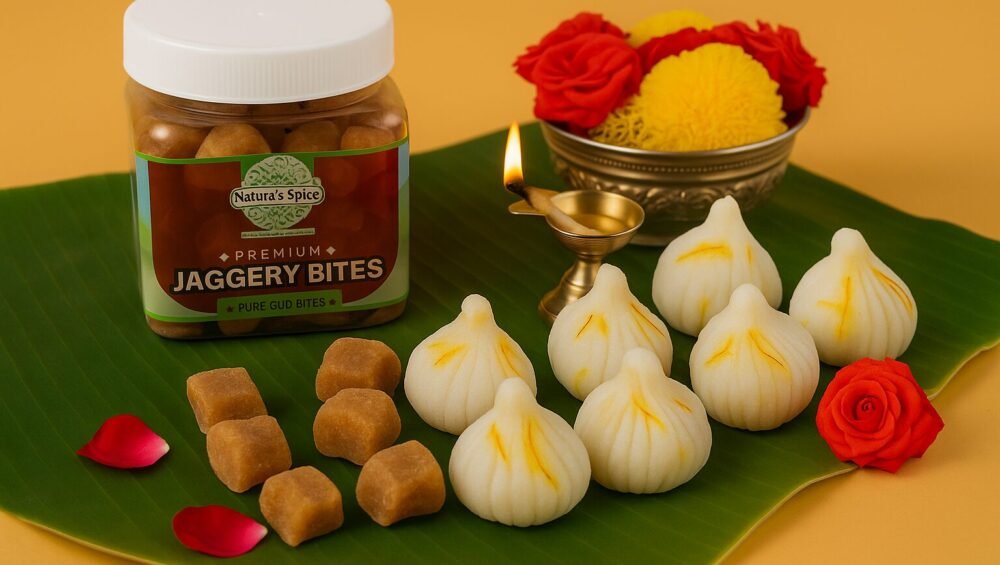Modak is not just a sweet dessert; it is a culturally entrenched bonding, particularly in Maharashtra, where it is the favored offering during Ganesh Chaturthi. This classic modak recipe, steamed with so much delicacy that the filling of coconut and jaggery merges into a tasty tradition, makes every bite a culinary delight for the tongue. Making a modak recipe at home makes you feel part of the festive tradition, and it is also good food and fun. This simple modak recipe is easy to follow, with step-by-step instructions so that you can make this sweet dish in your own kitchen.
What is Modak?
Modak is a soft dumpling made out of rice flour, with a yummy filling mixture of coconut and jaggery. Its shape also resembles a small pouch or pointed dome, which in Indian culture is basically symbolic of auspiciousness and sweetness. Modaks are cooked at all kinds of festivals, but are more popular in Maharashtra for Ganesh Chaturthi, when devotees offer them to Lord Ganesha. This native sweet has the taste and symbol of said sweet in deep culture, with really rave tastes lying in between.
Ingredients for Modak
The Modak should balance freshness for the perfect taste and flavor.
Rice flour: A cupful (non-sticky, ideally, finely ground)
Fresh coconut, grated: A cupful
Jaggery: Three-fourths of a cup (fresh jaggery cubes melted and strained)
Ghee: 2 tsp. (for frosting and greasing)
Cardamom powder: ½ tsp.
Green cardamom pods: 3-4 (crushed lightly for additional aroma)
Salt: a pinch to balance the flavors
Water: about a cup (for dough)
Tip: Using fresh grated coconut adds to the natural sweetness and texture of the filling. However, if fresh coconut is unavailable, one can always opt for frozen unsweetened grated coconut. In addition, melting jaggery on low heat and straining the mixture helps get rid of the impurities and ensures a smooth filling. The addition of Kashmiri saffron would intensify the flavor and aroma of the filling, while green cardamom pods give an authentic scent to the filling, perfect for festivity.
Modak recipe Step-by-Step
Dividing the process into steps helps beginners prepare modak without confusion. Pay attention to each step to achieve a soft, nicely shaped Modak.
Preparing the Dough
Begin by boiling water with salt and ghee. Gradually add rice flour while stirring carefully so no lumps are formed. As soon as the mixture thickens and sticks to the sides of the pan, take it off the fire. Let it cool a bit, then knead it into a soft dough. The dough must be elastic but not sticky.
Temperature is important. If the water is too warm, the dough is hard to work with. Work it while it is warm but comfortable temperature. Kneading thoroughly keeps the dough from cracking during shaping.
Preparing the Coconut-Jaggery Filling
In a pan, the grated coconut is heated together with melted jaggery. For aroma, add the cardamom powder. Cook on medium flame, stirring occasionally until it thickens enough to hold its shape under slight pressure, taking care to avoid overcooking the filling so that it remains moist.
This coconut-jaggery mixture is the heart of every Maharashtrian modak recipe, adding both sweetness and fragrance.
Shaping the Modak
Pinch out small portions of dough and roll into balls. With fingers or a rolling pin, the balls are flattened into thin discs. A spoonful of coconut-jaggery filling is poured in the middle. The edges of the disc are lifted up carefully and pinched together to seal the filling inside in the usual Modak shape. Pleating may be done by hand, or a mold may be used for consistent shapes.
Common issues arise when the dough tears or the filling starts leaking. To prevent these difficulties, keep the dough soft, as well as avoid rolling the discs too thin. Continuing with the folds and being patient will help in getting better at forming the shapes.
Steaming the Modak
Line the steamer or idli cooker with a muslin cloth or a clean kitchen towel to prevent the Modak from sticking. Arrange the Modak without overcrowding. Add water to the steamer, about 10-12 minutes on medium heat. They acquire a little bit of gloss when cooked.
Keep checking the water level in the pot at the midway point to ensure the dumplings are dried out by that time, and halfway check to prevent uneven steaming. Over-steaming makes the dough rubbery, whereas under-steaming leaves the dough raw.
Serving and Storing Modak
Modak tastes best when fresh and warm. Drizzle some ghee on them to make them even richer. Few may want to try it with hot cardamom-flavored milk for an indulgent snack.
If you want to store the Modak, keep them in the refrigerator in an airtight container for up to 2 days. Before serving, steaming the refrigerated Modak for a few minutes would soften them again. For a longer duration, tightly wrap and freeze the Modak, and steam it whenever needed.
How to Choose the Best Quality Jaggery Cubes Online
Perfect jaggery brings an extra touch of flavor and texture to the filling. Nature’s Spice offers pure jaggery cubes that undergo no artificial processing. These cubes melt evenly to provide a sweet, deep, and almost clean taste to Modak. Higher grades of jaggery ensure that the filling is well-bonded and tastes genuine. The options are open for one to explore and learn about the products on Nature’s Spice jaggery bites.
Conclusion
Making Modak at home reconnects you with an important cultural tradition while rewarding your effort with delightful, fragrant sweets. The process is straightforward yet calming when approached step-by-step. Each Modak carries the spirit of celebration and care, best enjoyed fresh with family and friends. Try this recipe to add a taste of Maharashtra’s festive tradition to your kitchen, and share the joy of making and savoring Modak with those around you.




